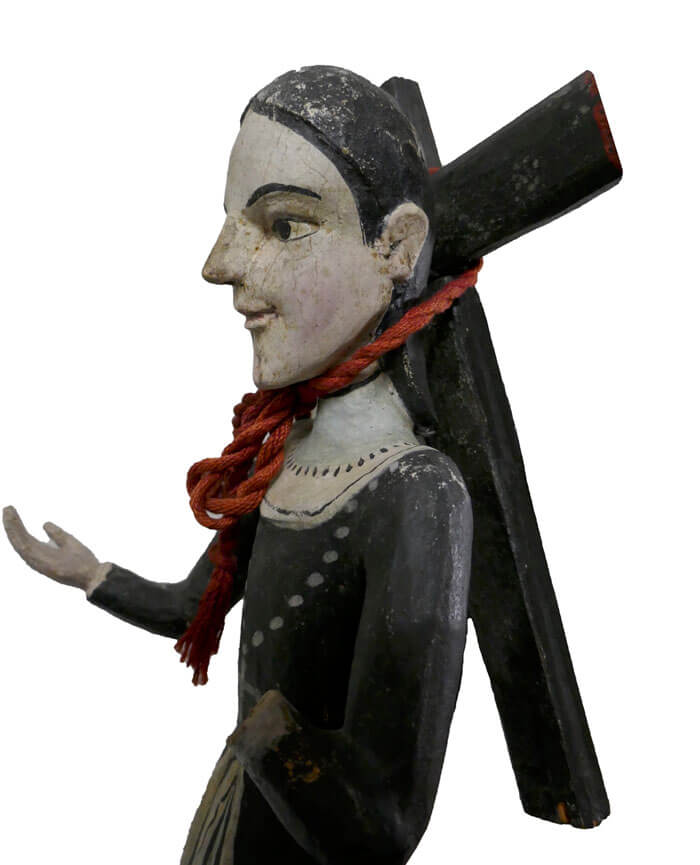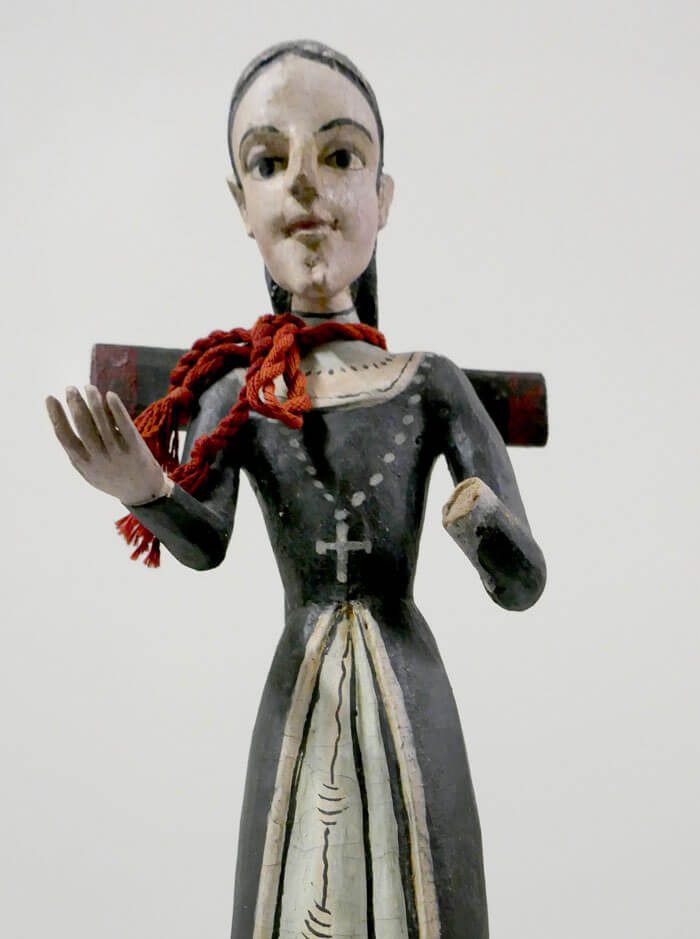
UNIDENTIFIED SAINT
Description: Carved bulto (a religious figure in the round, as opposed to a retablo, or two-dimensional painted representation)
Provenance: Duran Chapel, Ranchos de Taos
Accession date: ca. 1942
Category: Southwest Collection
Institution: Colorado Springs Fine Arts Center, Colorado College (formerly the Taylor Museum of the Colorado Springs Fine Arts Center)
On April 8, 1956, E. Boyd decided that a santo in the collection of Taylor Museum (named after Alice Bemis Taylor), now the Colorado Springs Fine Arts Center at Colorado College, was a fraud. Collected by the museum patron’s agent, one H.H. Garnett, the carved saint, or bulto, was originally from the Duran Chapel, located in Taos. Garnett, it was reported, had made the purchase from an unnamed Taos dealer.
During the interwar years, Boyd gained a reputation as a scholar of Spanish Colonial Arts. She even led the efforts to create the Portfolio of Spanish Colonial Design as part of the Index of American Design, a WPA-funded project to catalogue everything from furniture to fiber arts in America. As curator of the New Mexico Museum, Boyd was called upon to look at Taylor’s own collection of bultos and retablos from northern New Mexico and southern Colorado. This particular example, like many in the collection, had been repaired so many times—repainted, glued back together (though one hand was still missing), and embellished upon—that it was unclear who the saint actually was. Santos are typically identifiable from a few visual cues: a hollyhock for St. Joseph, a skull for St. Anthony, a castle for St. Barbara. Because this bulto had become such a refurbished pastiche and no longer attributed to one hand, it was recorded as “Nuestra Señora ?”
In her notes, Boyd, however, dubbed the bulto a “transvestite monk.” The face once bore a beard, which at some unknown point had been gessoed over and repainted. The only proof that it ever existed was in an especially jutting cleft chin. The dress had been repainted, too; once a monk’s habit, the garb had, with a few flourishes, become a nun’s habit. And then, as if the misguided patchwork wasn’t enough, a cross was added with a leather cord to make its wearer appear crucified.
The irony is that there once was a crucified female saint. Santa Librada was known in Catholic lore for praying so fervently to be made repulsive—so that she would not have to marry her Muslim suitor—that she grew facial hair. Her father, who had betrothed her, had her crucified as punishment. She was, even before Barnum and Bailey’s circus, the original bearded lady. Some still paint Librada with her whiskers; others, however, refrain.
In her notes for other santos in the collection, Boyd often recommended dunking the object in paint thinner to reveal its first iteration and, hopefully, authentic identity.
This santo was not intended, at least in its first iteration, to take Librada’s likeness. Nor do I think the santo ever truly was Librada. It was only after some time, and after one or several people took a few liberties, that she became the gender bender that Boyd confronted in the Taylor Museum’s vault. In her notes for other santos in the collection, Boyd often recommended dunking the object in paint thinner to reveal its first iteration and, hopefully, authentic identity. In other instances, she simply advised the museum to discard objects she considered to be the bad apples of the collection. She was ruthless in her notes, her disdain for the inauthentic seething off the page.
The unnamed saint remained, never dunked and never discarded. It is now evidence of the bricolage aesthetic inherent to santos and their makers and of the intense desire in the early twentieth century to collect authentic Spanish Colonial art at whatever cost. Perhaps a well-intended churchgoer-turned-community-conservator who thought the community needed a female saint had restored it without the proscriptions of a specific template. That was often the case as santos aged: they were repurposed. Or perhaps an unscrupulous dealer had made his own revisions quite simply to make the object look authentic, even if the result was somewhat confounding. Either way, the unidentified santo is one of those objects that resists any archival impulse to be properly defined. Instead, she or maybe he (perhaps both?) unsettles any rigid notions of authenticity.




